Unit 4- REPRO AND ENDO, Exams 4 iRAs 12-14
1/87
There's no tags or description
Looks like no tags are added yet.
Name | Mastery | Learn | Test | Matching | Spaced |
|---|
No study sessions yet.
88 Terms
One possible cause of adrenal hyperplasia (hyperactivity) may be over-proliferation (e.g. a tumor) of which PITUITARY cell type indicated in this trichrome-stained section?
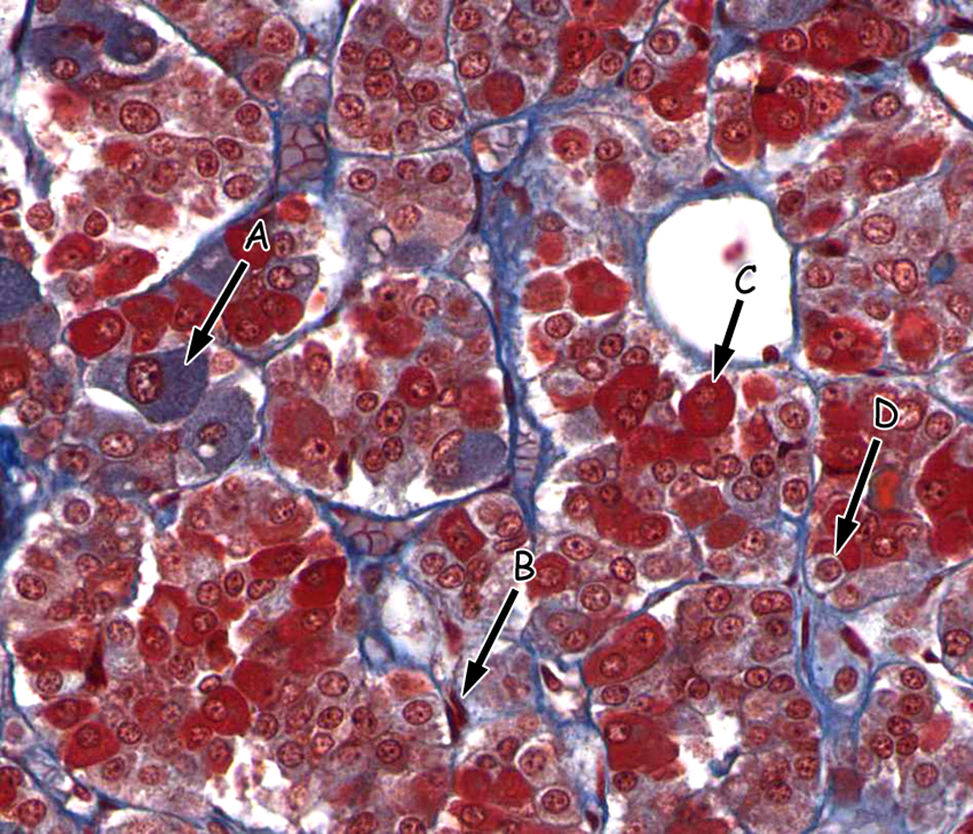
A. A
B. B
C. C
D. D
A
A patient suffered blunt trauma to her head, chest, abdomen and flank from front and side airbag deployment in a car accident last week. Since that time she reports that she has been very thirsty and needs to urinate very frequently. A urine sample is collected and its osmolarity is 150 mOsm/kg. Her blood pressure is on the low side of normal (110/60) and her plasma sodium is high (145 mmol/L). Cortisol levels are in the normal range (15 mcg/dL).
Based on the history and the findings, her symptoms are MOST LIKELY caused by:
A. decreased secretion of antidiuretic hormone from the posterior pituitary
B. decreased secretion of aldosterone from the adrenal gland
C. increased secretion of atrial natriuretic factor from the heart
D. increased secretion of angiotensin II from the kidney
E. decreased secretion of adrenocorticotropic hormone (ACTH) from the anterior pituitary
A. decreased secretion of antidiuretic hormone from the posterior pituitary
Which of the following is a steroid hormone?
A. thyroid hormone
B. luteinizing hormone (LH)
C. aldosterone
D. oxytocin
E. prolactin (PRL)
C. aldosterone
A patient that has an enlarged thyroid gland that presents as a goiter. Which of the following findings would be MOST suggestive of secondary hyperthyroidism?
A. decreased T3 in her blood
B. increased T4 in the blood
C. increased thyroid releasing hormone (TRH) in peripheral blood
D. increased thyroid stimulating hormone (TSH) in peripheral blood
E. decreased thyroid hormone carrier in her blood
D. increased thyroid stimulating hormone (TSH) in peripheral blood
Prior to awakening, plasma glucose levels rise in a normal / typical individual. The secretion of which of the following causes this increase?
A. aldosterone
B. DHEA
C. insulin
D. cortisol
E. vasopressin
D. Cortisol
Steroid hormones generally travel in the bloodstream bound to a carrier protein. What is a characteristic of steroid hormones that results from this mechanism of transport?
A. Steroid hormones are not filtered at the glomerulus
B. Steroid hormones are present in the blood at lower concentrations than peptide hormones
C. Steroid hormones are sensed by intracellular hormone receptors in their target cells
D. Steroid hormones are always secreted in an inactive prohormone form
E. Steroid hormones are removed from the body more quickly than peptide hormones
A. Steroid hormones are not filtered at the glomerulus
An adult male athlete is injecting testosterone daily attempting to improve his average running pace. The amount of hormone is sufficient to raise serum testosterone levels above standard, and he has been taking injections for about 4 months. What physiological metric would you expect to be increased in this athlete?
A. The size of the testes
B. Serum levels of luteinizing hormone
C. The rate of spermatogenesis
D. The rate of liver regeneration
E. The size of the prostate
E. The size of the prostate
Examine the organ indicated by the black arrow in the attached: https://www.digitalscope.org/ViewerUI/?SlideId=80f5a26f-7e32-43dc-b605-bc850e8ca5aa&ann=111000001
What would be the expected result if this organ becomes hyperactive due to a tumor?
A. tall stature due to overproduction of growth hormone
B. diabetes insipidus due to overproduction of vasopressin (antidiuretic hormone)
C. Cushing’s disease due to overproduction of glucocorticoids
D. high blood calcium levels
E. goiter
D. high blood calcium levels
Steroid hormones generally travel in the bloodstream bound to a carrier protein. What is a characteristic of steroid hormones that results from this mechanism of transport?
A. Steroid hormones are not filtered at the glomerulus
B. Steroid hormones are present in the blood at lower concentrations than peptide hormones
C. Steroid hormones are sensed by intracellular hormone receptors in their target cells
A. Steroid hormones are not filtered at the glomerulus
D. Steroid hormones are always secreted in an inactive prohormone form
E. Steroid hormones are removed from the body more quickly than peptide hormones
A. Steroid hormones are not filtered at the glomerulus
In the attached slide: https://www.digitalscope.org/ViewerUI/?SlideId=fdec4e5b-7384-4e76-b889-c3bd84e6f77e&ann=111000001
the tip of the arrow is in the lumen of what structure?
A. rete testis
B. efferent ductules
C. epididymis
D. ductus deferens
E. seminiferous tubules
A. rete testis
In a 16-year-old male, what would be an expected consequence of an inactivating mutation in aromatase?
A. continual growth of the skeleton
B. loss of secondary sexual characteristics
C. prostatic hypertrophy
D. increased breast size
E. markedly decreased spermatogenesis
A. continual growth of the skeleton
Which cell type shown would have the most abundant receptors for luteinizing hormone (LH)?

A. A
B. B
C. C
D. D
E. E
B.
A recent MBS graduate reports to a local testing center the day of her scheduled MCAT exam. This is her first attempt at taking the MCAT, and she has the feeling of “butterflies in her stomach.” What is the physiological role of epinephrine while the student is in this situation?
A. Epinephrine binds to receptors on the pituitary to stimulate the release of insulin which mobilize glucose stores from the liver.
B. Epinephrine binds to receptors on the liver to stimulate the release of glucagon to increase glucose uptake from the blood.
C. Epinephrine binds to receptors on the liver to increase the amount of glycogen synthesis.
D. Epinephrine binds to receptors on adipose tissue to stimulate mobilization of fatty acids to the liver.
E. Epinephrine is not active in this student as MBS prepared her for the MCAT and she is confident she will knock this test out of the park.
D. Epinephrine binds to receptors on adipose tissue to stimulate mobilization of fatty acids to the liver.
The zones of the adrenal gland are labeled in the attached image. Which zone synthesizes the largest amount of mineralocorticoids (such as aldosterone)?

A. A
B. B
C. C
D. D
E. E
B.B
Suppose a new male contraceptive pill is developed that blocks the initial stages of sperm production. How long would a patient MOST LIKELY have to take the medication before it was fully effective at preventing pregnancy?
A. 24 hours
B. 1 week
C. 3 weeks
D. 3 months
E. 1 year
D. 3 months
Which structure is NOT derived from the metanephric blastema?
A. Collecting duct
B. Loop of Henle
C. Distal convoluted tubule
D. Podocytes
E. Proximal convoluted tubule
A. Collecting Duct
The presence of testes or ovaries determines:
A. chromosomal sex
B. genetic sex
C. gonadal sex
D. phenotypic sex
E. gender
C. gonadal sex
Which of the following is derived from the ureteric bud?
A. bladder
B. urethra
C. collecting duct of the kidney
D. proximal convoluted tubules of the kidney
E. allantois
C. collecting duct of the kidney
Which of the following is derived from the metanephric blastema?
A. bladder
B. urethra
C. collecting duct of the kidney
D. proximal convoluted tubules of the kidney
E. allantois
D. proximal convoluted tubules of the kidney
Before the adult kidneys are formed, which structures perform the kidneys’ function for the early embryo?
A. the mesonephros
B. the pronephros
C. the metanephros
D. the ureteric bud
E. the metanephric blastema
A. the mesonephros
What is the result in of an utereric bud prematurely dividing before penetrating the metanephric blastema in a developing fetus?
A. a child born with two urinary bladders
B. a child born with three kidneys
C. a child with both a penis and a vagina
D. a child born with two prostate glands
E. a child born with two urethras
B. a child born with three kidneys
What structure gives rise to the upper 1/3 of the vagina?
A. urogenital sinus
B. genital swellings
C. paramesonephric ducts
D. mesonephric ducts
E. ureteric bud
C. paramesonephric ducts
Which of the following is derived from mesonephric (Wolffian) ducts?
A. lower 2/3 of vagina
B. bladder
C. proximal convoluted tubules of the kidney
D. uterus
E. epididymis
E. epididymis
The male and female reproductive system both have structures derived from the genital tubercle, which produces erectile tissue. What structure in the female reproductive system develops from the primordial genital tubercle tissue?
A. the labia minora
B. the labia majora
C. the Bartholin glands
D. the clitoris
E. the mons pubis
D. the clitoris
What condition causes the mesonephric duct to regress?
A. no testosterone production
B. high levels of testosterone production
C. no estrogen production
D. high levels of estrogen production
E. none of the above
A. no testosterone production
During pregnancy, milk production is inhibited by:
A. low levels of estrogen
B. high levels of estrogen
C. low levels of oxytocin
D. high levels of prolactin
E. high levels of placental lactogen
B. high levels of estrogen
In the image below, which part of the follicle produces estrogen?
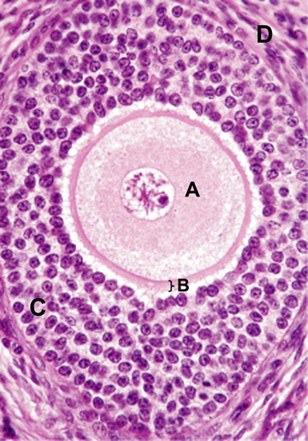
A. A
B. B
C. C
D. D
C. C
In the image below, which part of the follicle contains cells that are directly stimulated by LH?

A. A
B. B
C. C
D. D
D. D
In the proliferative phase of the menstrual cycle, the glands of the uterus proliferate in direct response to what hormone?
A. progesterone
B. inhibin
C. testosterone
D. estrogen
E. luteinizing hormone
D. estrogen
Why is a progestogen/progestin added to estrogen therapy in a woman with a uterus interested in starting menopausal hormone therapy (MHT)?
A. It lowers the risk of VTE (DVT, pulmonary embolism)
B. It helps protect the lining of the uterus and prevents the increased risk of endometrial cancer
C. It decreases the incidence of insomnia
D. It increases libido
E. It counteracts the loss in bone density common during menopause
B. It helps protect the lining of the uterus and prevents the increased risk of endometrial cancer
In a woman of reproductive age, which hormone is most potent and found in the highest concentration in blood plasma?
A. estrone
B. estriol
C. estradiol
D. androstenedione
E. testosterone
C. estradiol
At which stage of life do you expect an ovary to contain the largest number of primordial follicles?
A. birth
B. onset of puberty
C. age at first pregnancy
D. perimenopause
E. menopause
A. birth
Which of the following events does NOT happen during the gonadotropin-dependent phase of follicular development:
A. LH stimulates cells of the theca interna to produce testosterone
B. FSH stimulates granulosa cells to express aromatase
C. Granulosa cells upregulate expression of FSH and LH receptors
D. Serum estrogen levels drop to baseline levels
E. Granulosa cells upregulate expression of inhibin
D. Serum estrogen levels drop to baseline levels
Identify the organ shown in the following: https://www.digitalscope.org/ViewerUI/?SlideId=90350a8f-356f-4971-b000-bd45a04ce008&ann=111000001
A. menstrual phase uterus
B. proliferative phase uterus
C. secretory phase uterus
D. vagina
E. cervix
C. secretory phase uterus
Examine the cells at the tip of each black arrow in https://www.digitalscope.org/ViewerUI/?SlideId=8977f416-ff4c-44bc-bd92-6aea4a593e3f&ann=111000001.
All of the following statements about these cells are true, EXCEPT for one. Please identify the exception.
A. They originate from theca interna cells
B. The secretory activity of the cells correlates with the secretory phase of the uterus
C. Their cytoplasm contains abundant smooth endoplasmic reticulum
D. They produce luteinizing hormone (LH)
E. They produce androgens
D. They produce luteinizing hormone (LH)
You are shadowing a medical oncologist who has an appointment with a 63-year-old female patient with Stage 1 breast cancer. The patient’s tumor tested positive for the estrogen receptor, and the oncologist needs to counsel her on appropriate medical therapies to reduce her risk of recurrence. You suggest starting an aromatase inhibitor drug, like tamoxifen. Why would an aromatase inhibitor be appropriate treatment?
A. Aromatase inhibitors will prevent LH release from the pituitary despite stimulation by GnRH
B. Aromatase inhibitors will prevent FSH and LH release due to excess estrogen production
Correct answer:
C. Aromatase inhibitors will prevent the conversion of testosterone to estrogen
D. Aromatase inhibitors will upregulate the production of GnRH in the hypothalamus
E. Aromatase inhibitors will enhance the secretion of testosterone
C. Aromatase inhibitors will prevent the conversion of testosterone to estrogen
All of the following tissues are directly impacted by estrogen EXCEPT for one. Please identify the exception.
A. heart
B. kidney
C. bone
D. brain
E. uterine
B. kidney
An ovum is successfully fertilized and results in a pregnancy. Where within the female reproductive system did fertilization MOST LIKELY occur?
Correct answer:
A. The ampulla of the oviduct.
B. The isthmus of the oviduct.
C. The intramural (uterine) segment of the oviduct.
D. The infundibulum of the oviduct.
E. The endometrium of the uterus.
A. The ampulla of the oviduct.
If a patient began taking a daily oral progesterone pill on day 3 of her cycle (immediately after finishing menses), the pill would be a very effective form of birth control. Increasing progesterone levels at the start of her cycle would cause several conditions that make pregnancy unfavorable. Which of the following is NOT a mechanism of pregnancy prevention caused by progesterone?
A. GnRH levels do not return to the appropriate level to stimulate FSH production
B. The corpus luteum does not degrade as usual, preventing menses.
C. The cervical mucus becomes very thick, preventing sperm from entering the uterus.
D. The secretory phase of the uterus is stimulated prematurely.
E. The proliferative phase of the uterus is not completed.
B. The corpus luteum does not degrade as usual, preventing menses.
Identify the type of follicle within the black box in the figure below.
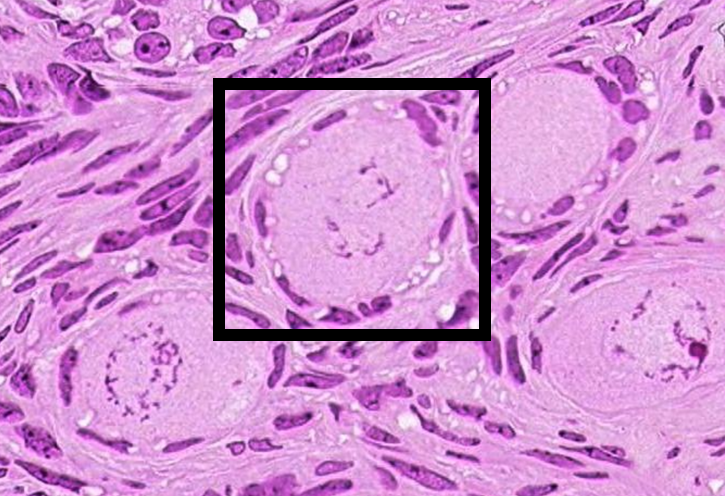
A. primordial
B. early primary
C. late primary
D. secondary
E. Graafian
A. primordial
Which of the following is derived from mesonephric (Wolffian) ducts?
A. lower 2/3 of vagina
B. bladder
C. proximal convoluted tubules of the kidney
D. uterus
E. epididymis
E. epididymis
What structure gives rise to the upper 1/3 of the vagina?
A. urogenital sinus
B. genital swellings
C. paramesonephric ducts
D. mesonephric ducts
E. ureteric bud
C. paramesonephric ducts
In a healthy individual, a rise in cortisol would cause each of the following effects except for one. Please identify the exception.
A. Enhanced rate of glucose synthesis by the liver
B. Increased rate of glycogen usage by the liver
C. Higher levels of fatty acids in the blood
D. Suppression of the immune system
E. Increased ACTH levels
E. Increased ACTH levels
A 46,XY individual presents with unusually high ACTH levels due to congenital adrenal hyperplasia. What differences of sexual development would you expect to see in this individual?
A. undescended testes
B. external genitalia are phenotypically female
C. male external genitalia, but a small uterus and uterine tubes are present
D. This patient would not present with DSDs
E. Congenital adrenal hyperplasia is not possible with a 46,XY patient
D. This patient would not present with DSDs
Examine the basophilic cells indicated in this: https://www.digitalscope.org/ViewerUI/?SlideId=88ad585f-7023-4756-8311-c17e0cf145ac&annotate=1
What do these cells produce?
A. growth hormone
B. FSH
C. ADH (vasopressin)
D. calcitonin
E. epinephrine or norepinephrine
E. epinephrine or norepinephrine
Examine the structure in the boxed region on this: https://www.digitalscope.org/ViewerUI/?SlideId=6adbd7ff-2cf6-4c60-8fb2-b44f9dd7ba98
Why is this structure classified as endocrine tissue?
A. Cells in this nest within the anterior pituitary release hormones that directly inhibit the actions of target organs.
B. Cells within this zone of the adrenal cortex release steroid hormones that migrate to the nucleus of target cells and directly regulate gene expression.
C. Cells lining this follicle in the thyroid produce hormones derived from amino acids.
D. Cells of this pancreatic islet produce hormones that are released directly into the bloodstream.
E. Cells within this region of the neurohyphophysis receive neural input from the hypothalamus, allowing for integration of nervous input and body response
D. Cells of this pancreatic islet produce hormones that are released directly into the bloodstream.
Basophils within the pituitary produce all of the following hormones except for one. Please identify the exception.
Correct answer:
A. GH
B. FSH
C. LH
D. ACTH
E. TSH
A. GH
Examine the cell indicated at the tip of the arrow on this: https://www.digitalscope.org/LinkHandler.axd?LinkId=ed0333f4-dc7f-4e57-9cc1-f8b3e3d0b0da&X=7768.855473355981&Y=4478.251122513358&Z=100&ann=111000001000000
What stimulus would cause this cell to secrete its hormone?
A. low plasma sodium concentration
B. high plasma concentration of calcium
C. ACTH release from the pituitary gland
D. low blood glucose levels
E. increased TSH release from the pituitary gland
B. high plasma concentration of calcium
Acromegaly leading to gigantism is caused by the excessive secretion of hormone from which of the following labeled cells?
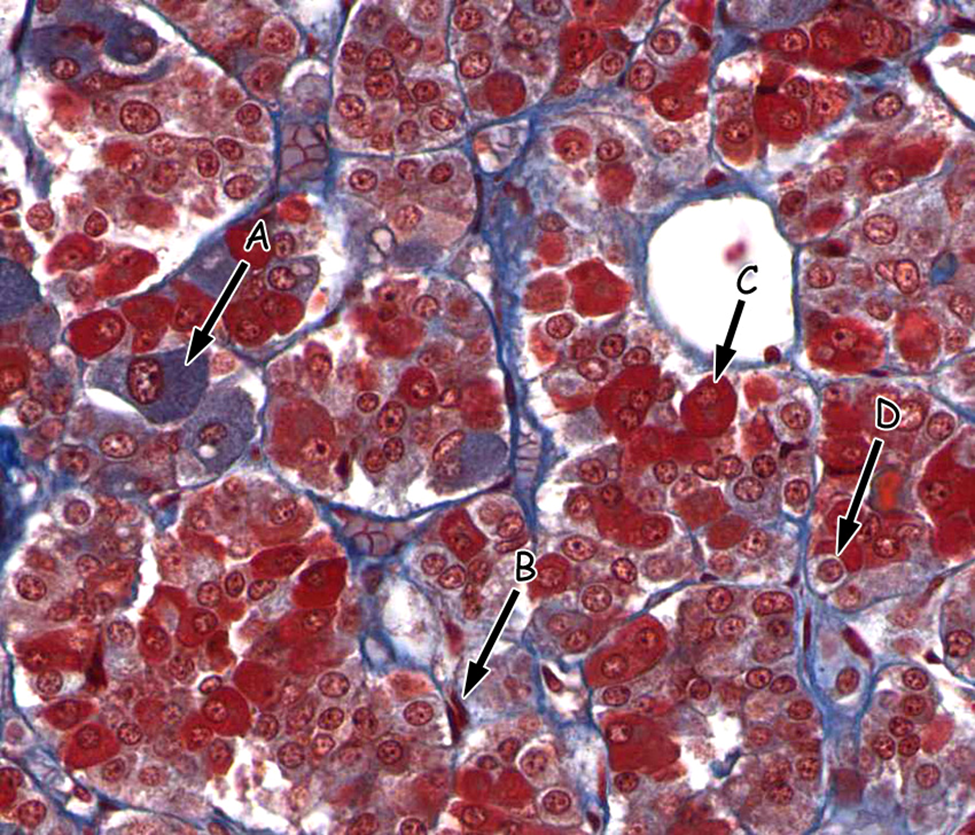
A. A
B. B
C. C
D. D
C. C
When insulin is released from the beta cell of a pancreatic islet, glucagon secretion is inhibited from the alpha cells of the islet. What type of signaling response is this called?
A. autocrine
B. paracrine
C. endocrine
D. synaptic
E. communication through gap junctions
B. paracrine
Which of the following hormones acts specifically on myoepithelial cells to elicit contraction and milk ejection during suckling?
A. estrogen
B. progesterone
Correct answer:
C. oxytocin
D. prolactin
E. epinephrine
C. oxytocin
Please use the following scenario to answer the following three questions:
A patient is referred to an endocrinology clinic after presenting to her primary care doctor with weight loss and extreme fatigue. She reports that her blood pressure has been low for weeks, so low that she has fainted several times. She also says she wants to eat salty food.
1.What endocrine organ has MOST LIKELY started to fail in this patient?
A. Pituitary gland
B. Thyroid gland
C. Pancreatic islets
D. Ovaries
E. Adrenal gland
2.If this is a primary endocrine pathology, what hormone would be elevated in this patient?
A. ACTH
B. Prolactin
C. TSH
D. Glucagon
E. FSH
3. What do you expect to observe regarding this patient’s blood glucose level, and why?
A. This patient would be hypoglycemic. If the pituitary gland is failing, it cannot direct the liver to break down glycogen and send glucose into the blood.
B. This patient would be hypoglycemic. If the thyroid gland is failing, it cannot assist in the mobilization of glucose stores from the skeletal muscles into the blood.
C. This patient would be hypoglycemic. If the adrenal gland is failing, it cannot assist in the mobilization of fat to the liver which increases blood glucose levels.
D. This patient would be hyperglycemic. If the pancreatic islets are failing, glucagon is not inhibited by insulin and glucose will be mobilized from the liver at all times.
E. This patient would be hyperglycemic. If the ovaries are failing, progesterone will be secreted into the blood at all times and synergize with cortisol to mobilize fatty acids to the liver.
1.E. Adrenal Gland.
2. A. ACTH
3. C. This patient would be hypoglycemic. If the adrenal gland is failing, it cannot assist in the mobilization of fat to the liver which increases blood glucose levels.
The zones of the adrenal gland are labeled in the attached image. Overactivity of cells in which zone would cause virilization within women?

A. A
B.B
C. C
D.D
E.E
D. D
Which of the following statements about steroid hormones is FALSE?
A. Steroid hormones are derived from pregnenolone, which is produced from cholesterol.
B. Endocrine cells produce and store steroid hormones ahead of time and secrete them in bursts, as needed.
C. Steroid hormones are not soluble in the blood plasma and must circulate bound to carrier proteins.
D. Steroid hormones are not active when they are bound to a carrier protein.
E. Steroid hormones bind to intracellular receptors and usually activate transcription.
B. Endocrine cells produce and store steroid hormones ahead of time and secrete them in bursts, as needed.
The hypothalamus-pituitary gland axis controls all of the following physiological processes except for one. Please identify the exception.
A. Growth
B. Metabolism
C. Response to stress
D. Reproduction
E. Plasma Na+ concentration
E. Plasma Na+ concentration
Which hormone plays a pivotal role in the maintenance of body temperature?
A. calcitonin
B. parathyroid hormone
C. triiodothyronine
D. growth hormone
E. glucagon
C. triiodothyronine
A drug that blocks the action of deiodinase would cause which of the following effects?
A. Increased mental alertness
B. Rapid heart rate
C. A decrease in basal body temperature
D. Production of a goiter
E. Weight loss
C. A decrease in basal body temperature
Which of the following is derived from the ureteric bud?
A. bladder
B. urethra
C. collecting duct of the kidney
D. proximal convoluted tubules of the kidney
E. allantois
C. collecting duct of the kidney
What is the pathway of testosterone production in the male?
A. Follicle-stimulating hormone acts on Leydig cells to produce testosterone.
B. Luteinizing hormone acts on Leydig cells to produce testosterone.
C. Follicle-stimulating hormone acts on Sertoli cells to produce testosterone.
D. Kisspeptin acts on spermatogonia to produce testosterone.
E. Luteinizing hormone acts on spermatogonia to produce testosterone.
B. Luteinizing hormone acts on Leydig cells to produce testosterone.
Suppose a mutation occurs in a biological male that inactivates the FSH receptor. What would be the MOST LIKELY physiological consequence of this mutation?
A. swelling of the testis
B. low testosterone levels in the blood
C. loss of Leydig cells in the testis
D. prostatic hypertrophy
E. decreased levels of inhibin in the blood
E. decreased levels of inhibin in the blood
What hormonal abnormality would you expect to see in a male with a 5-alpha reductase deficiency?
A. abnormally low levels of dihydrotestosterone (DHT)
B. abnormally high levels of dihydrotestosterone (DHT)
C. abnormally low levels of cortisol
D. abnormally high levels of dehydroepiandrosterone (DHEA)
E. abnormally high levels of luteinizing hormone
A. abnormally low levels of dihydrotestosterone (DHT)
Examine the attached image. As part of the reproductive system, the tube shown connects two other structures. What are they?

A. rete testis to epididymis
B. infundibulum of oviduct to uterus
C. mammary gland acinus to interlobular duct
D. epididymis to seminal vesicle
E. seminal vesicle to prostatic urethra
A. rete testis to epididymis
Which of the labeled cells is a stem cell for sperm production?
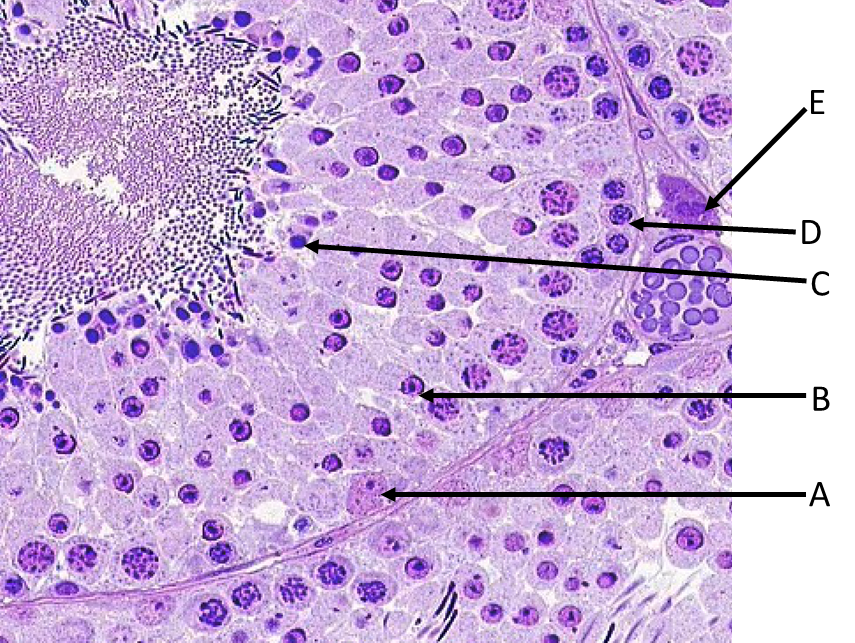
A. A
B. B
C. C
D. D
E. E
D. D
Which of the labeled cells secretes androgen binding protein involved in sperm maturation?
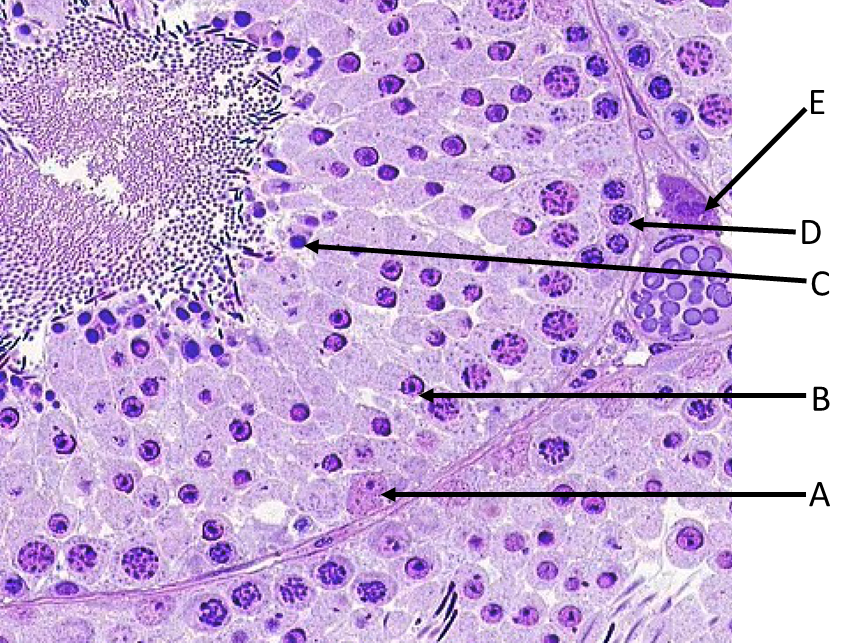
A. A
B. B
C. C
D. D
E. E
A.A
If FSH levels were temporarily reduced in an adult male, perhaps via a male contraceptive drug, what effect would you expect to observe?
A. Increased production of androgen binding protein by Sertoli cells
B. Increased production of inhibin by Sertoli cells
C. Decreased meiosis of spermatocytes
D. Decreased sex drive
E. Increased GnRH secretion
C. Decreased meiosis of spermatocytes
Drugs that treat erectile dysfunction, like Viagra and Cialis, promote smooth muscle relaxation in the erectile tissues of the penis. These drugs directly inhibit the breakdown of which molecule?
A. cGMP
B. intracellular calcium
C. cAMP
D. NO
E. GPCRs
A. cGMP
Which classification of sex would be determined by the presence or absence of SRY?
A. gonadal sex
B. chromosomal sex
C. genetic sex
D. phenotypic sex
E. gender
C. genetic sex
What is the key feature that indicates that the ovarian follicle in the image below is a late primary follicle?
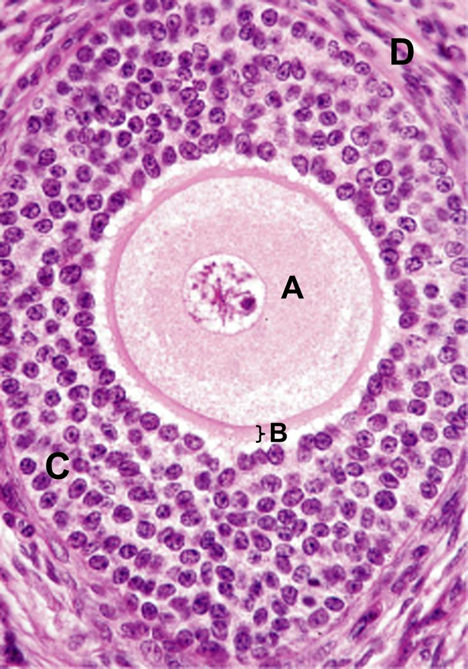
A. the presence of an antrum
B. the granulosa cells are stratified
C. the clumped chromosomes in the oocyte nucleus
D. the distinct cumulus oophorus
E. the presence of the zona pellucida
B. the granulosa cells are stratified
Examine the specimen in this: https://www.digitalscope.org/ViewerUI/?SlideId=9099a07e-9c8b-47e1-a703-0a77d7e89c57&ann=111000101
What organ is MOST LIKELY shown?
A. thyroid gland
B. prostate
C. seminal vesicle
D. inactive mammary gland
E. active mammary gland
E. active mammary gland
Examine the specimen in this [virtual slideLinks to an external site.]. What organ is MOST LIKELY shown?
A. ductus (vas) deferens
B. oviduct
C. seminal vesicle
D. ureter
E. uterus
B. oviduct
Examine the following: https://www.digitalscope.org/ViewerUI/?SlideId=e2980f50-f39f-407b-a39b-0f11972393a3
What is this glandular tissue shown most likely from?
A. seminal vesicle
B. prostate
C. active mammary gland
D. secretory phase endometrium
E. proliferative phase endometrium
E. proliferative phase endometrium
In the image below, identify the part of the follicle that produces estrogen.
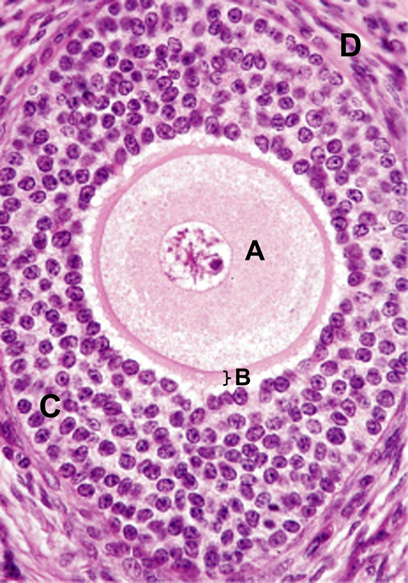
A. A
B. B
C. C
D. D
C. C
Hormones produced by which of the following organs directly determine the phase of the uterus?
A. uterus
B. hypothalamus
C. anterior pituitary
D. ovary
E. posterior pituitary
D. Ovary
During the secretory phase of the menstrual cycle, what hormone causes the differentiation of the glands in the uterus?
A. progesterone
B. estrogen
C. testosterone
D. inhibin
E. luteinizing hormone
A. progesterone
During the first three months of pregnancy, the glands and vessels of the uterine endometrium must be maintained to support the fetal placenta. Which of the following BEST DESCRIBES the hormonal actions that maintain these glands?
A. Indirect actions of human chorionic gonadotropin (hCG) from the placenta
B. Indirect actions of follicle stimulating hormone from the anterior pituitary
C. Indirect actions of oxytocin from the posterior pituitary
D. Direct actions of luteinizing hormone from the corpus luteum
E. Direct actions of estrogen and progesterone produced by the fetal adrenal glands
A. Indirect actions of human chorionic gonadotropin (hCG) from the placenta
In biologically female people, LH levels spike at mid-cycle. Why does the serum level of LH rise so sharply, but there is not a comparable increase in serum FSH levels?
A. LH and FSH are secreted by different endocrine organs.
B. LH and FSH are stimulated by different hypothalamic hormones.
C. By the time of the LH surge, FSH production is already at its highest level.
D. At the time of the LH surge, inhibin suppresses FSH secretion.
E. There is a surge of FSH that is equal to the LH surge, but it isn’t physiologically relevant.
D. At the time of the LH surge, inhibin suppresses FSH secretion.
As ovarian follicles mature, granulosa cells develop which produce estrogen. This estrogen feeds back to the pituitary to stimulate FSH release, which causes more granulosa cells to develop and therefore produce more estrogen. What is this type of regulation called?
A. Positive feedback
B. Negative feedback
C. Thermoregulation
D. Ovulation
E. Menstruation
A. Positive feedback
If the ovaries were removed from an otherwise healthy 20-year-old female, which of the following would you expect to see?
A. decreased blood levels of FSH
B. decreased blood levels of LH
C. longer menstrual cycles (more days between each cycle)
D. increased blood levels of GnRH
E. heavier menstrual cycles (more endometrium is lost at each cycle)
D. increased blood levels of GnRH
Which of the following statements about the action of LH in the ovary is FALSE?
A. LH causes granulosa cells to produce progesterone.
B. LH causes granulosa cells to produce progesterone receptors.
C. LH causes the oocyte to complete its second meiotic division and become fully mature.
D. Ovulation is triggered 16-20hrs after the LH surge.
E. LH causes the theca cells of the follicle to become theca lutein cells.
C. LH causes the oocyte to complete its second meiotic division and become fully mature.
Mammary glands fully develop during pregnancy, but the production of milk is inhibited until delivery of the baby. Which hormone signal is responsible for suppressing milk production until delivery?
A. high levels of progesterone from the placenta
B. high levels of prolactin from the pituitary
C. high levels of oxytocin from the pituitary
D. high levels of estrogen from the placenta
E. high levels of placental lactogen from the placenta
D. high levels of estrogen from the placenta
How does high levels of synthetic estrogen from oral contraceptives prevent pregnancy?
A. Estrogen directly inhibits follicle maturation
B. Estrogen promotes follicle atresia
C. Estrogen inhibits the proliferative phase of the uterus
D. Estrogen thickens the cervical mucus to prevent sperm entry
E. Estrogen suppresses pituitary release of FSH
E. Estrogen suppresses pituitary release of FSH
Which of the following is the most accurate description of a menopausal hormonal profile?
A. high FSH, high estrogen, high inhibin
B. high FSH, low estrogen, low inhibin
C. low FSH, low estrogen, low inhibin
D. low FSH, low estrogen, high inhibin
E. low FSH, high estrogen, high inhibin
B. high FSH, low estrogen, low inhibin
A menopausal woman is started on an estrogen-only hormone therapy to relieve the symptoms of menopause. What is a possible side effect of this hormone regimen?
A. Decrease in libido
B. Accelerated loss of bone density
C. Increased incidence of insomnia
D. Endometrial overgrowth and increased risk of endometrial cancer
E. Re-establishing monthly menses
D. Endometrial overgrowth and increased risk of endometrial cancer
A healthy 23-yo XX woman visits her OBGYN for her annual physical. She is not on hormonal birth control and experiences very regular 28-day cycles.The provider takes a blood draw as part of the routine workup. The draw was taken on day 20 of her cycle. What do you expect to see in her lab results?
A. Estrogen levels are near zero, and progesterone levels are very high.
B. Estrogen levels are high, but progesterone levels are much higher than estrogen levels.
C. Estrogen and progesterone levels are both near zero.
D. Estrogen levels are low (not zero), and progesterone levels are high.
E. Estrogen and progesterone levels are both very high.
B. Estrogen levels are high, but progesterone levels are much higher than estrogen levels.
Mifepristone is a drug currently at the center of political debate with national implications as it is used to induce medication termination of early pregnancies. It disrupts an early pregnancy by antagonizing one hormone, blocking its action and DIRECTLY initiating menses. Which hormone does mifepristone target?
A. estrogen
B. LH
C. GnRH
D. progesterone
E. testosterone
D. progesterone
Clomiphene is a common fertility drug that can cause superovulation (ovulation of more than one oocyte each cycle). It works by antagonizing receptors in the brain for which hormone?
A. progesterone
B. hCG
C. estrogen
D. GnRH
E. testosterone
C. estrogen
How do synthetic progestins primarily act to prevent a pregnancy from occurring?
A. suppression of ovulation
B. prevention of implantation of a fertilized embryo
C. thickening cervical mucus
D. inhibition of sperm capacitation
E. prevention of follicle maturation
E. prevention of follicle maturation
The birth control pill is widely prescribed to prevent pregnancy, but it is also prescribed because it has therapeutic effects aside from preventing pregnancy. These non-contraceptive beneficial effects of combination oral contraceptives include all of the following except for one. Please identify the exception.
A. Decreased pain during menstruation]
B. Decreased bleeding during menstruation
C. Decreased acne
D. Decreased risk of DVT
E. Decreased hirsutism (excessive hair growth)
D. Decreased risk of DVT